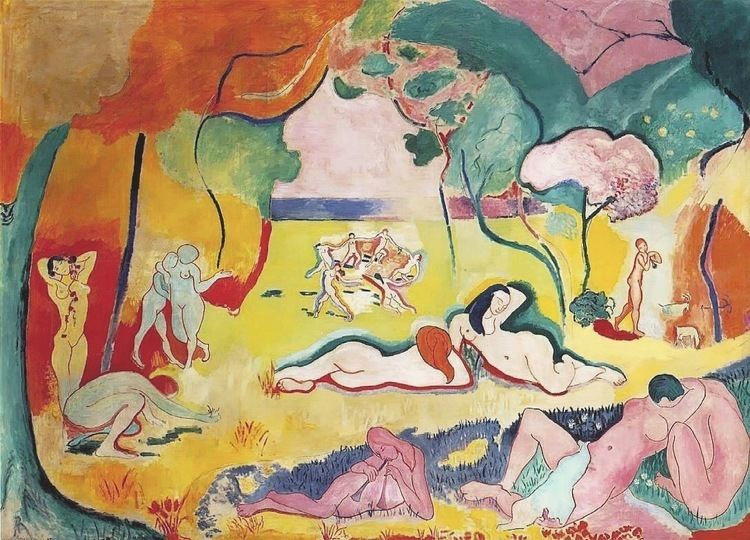Medium Oil on canvas Location Barnes Foundation Created 1905–1906 Media Oil paint | Artist Henri Matisse Period Fauvism Genre History painting | |
 | ||
Year Between October 1905 and March 1906 Dimensions 176.5 cm × 240.7 cm (69.5 in × 94.75 in) Similar The Open Window (Matisse), Green Stripe, The Dessert: Harmony in Red (The Red Room) | ||
Le bonheur de vivre (The Joy of Life) is a painting by Henri Matisse. Along with Picasso's Les Demoiselles d'Avignon, Le bonheur de vivre is regarded as one of the pillars of early modernism. The monumental canvas was first exhibited at the Salon des Indépendants of 1906, where its cadmium colors and spatial distortions caused a public expression of protest and outrage.
Contents
Description
In the central background of the piece is a group of figures that is similar to the group depicted in his painting The Dance (1909-10). In the picture, there are several nude bodies of women and men in a landscape drenched with vivid color.
Inspiration
“The work is known to have invigorated fellow artists, especially Pablo Picasso, who, in an effort to outdo Matisse in terms of shock value, immediately began work on his watershed Les Demoiselles D’Avignon,” writes Martha Lucy, associate curator at the Barnes Foundation.
James B. Cuno and Thomas Puttfarken suggest that the inspiration for the work was Agostino Carracci's engraving of Reciproco Amore or Love in the Golden Age after the similarly named painting by the 16th-century Flemish painter Paolo Fiammingo. Based on the many similarities with the engraving, in particular its theme of pastoral fantasy and its composition with the circle of dancers in the background, Cuno came to the conclusion that Carracci's engraving had a decisive influence on the final composition of Le Bonheur de Vivre.
According to Hilton Kramer Le bonheur de vivre, owing to its long sequestration in the collection of the Barnes Foundation which never permitted its reproduction in color, is the least familiar of modern masterpieces. Yet this painting was Matisse's own response to the hostility his work had met with in the Salon d'Automne of 1905, a response that entrenched his art even more deeply in the esthetic principles that had governed his Fauvist paintings which had caused a furor and which did so on a far grander scale, too." (The "sequestration" Kramer referred to relates to the very limited hours of the museum, when its collection was located in suburban Merion, Pennsylvania; in 2012, the collection was moved to a new, more accessible facility in downtown Philadelphia.)
Conservation
Le bonheur de vivre features a large amount of cadmium sulfide-based yellow. Portions of the painting containing cadmium sulfide are turning white or brown, degrading the work. University of Delaware Prof. Robert L. Opila, in collaboration with Barbara Buckley, head of conservation at the Barnes, and Jennifer Mass, a senior scientist and head of the Scientific Research and Analysis Laboratory at Winterthur, studied the paint’s material microstructure in an attempt to determine why the cadmium sulfide is changing color.
“It is a very disheartening phenomenon, considering the painting’s position in history,” says Opila, professor of materials science at UD.
Preliminary tests carried out by UD doctoral student Jonathan Church at the European Synchrotron Radiation Facility (ESRF) in Grenoble, France, show that carbon dioxide is reacting with the cadmium sulfide, causing the formation of cadmium carbonate, which is white. Also, the presence of chloride in the paint appears to be acting as a catalyst for the deterioration. Opila and his research team theorize that the binder, an oil similar to linseed oil, may be turning brown.
“The scientific studies being undertaken will contribute significantly to the preservation of the painting and to our understanding of the change that has taken place to the visual appearance of the painting,” says Buckley.
